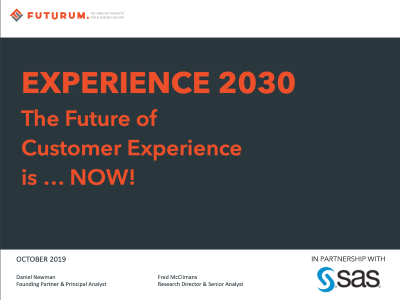CDPs Could Revolutionize the Way We Drive — And Improve Dozens of Other Everyday Products Too
February 3, 2020Self-driving cars could prove to be a wonderful technological advancement, but what is there to help drivers in the meantime, before the technology becomes generally available and accepted everywhere? The answer might just lie in the same AI, analytics, and data technology that customer data platforms (CDPs) use to help marketers understand their customers. An interesting example is a new Advanced Driver Assistance System (ADAS) that electronics giant Pioneer recently introduced.
The Pioneer ADAS system uses real-time data streams from a variety of sources — weather data to determine driving conditions from moment to moment, car instrument data on the driver’s abilities and habits, road data, IoT data, and more. With the help of AI and machine learning, the Pioneer system comes up with a constantly updated display that shows how likely the driver is to have an accident at any given moment. Drivers can influence the “score” by slowing down, driving less aggressively, and by generally being more cautious.
How Pioneer’s ADAS Uses Predictive Modeling to Help Drivers with Real-world Hazards
But how would that look in our everyday lives? Picture this scenario.
You’re driving to work, the same route you take every day. But this time, a storm passes over: you’re suddenly faced with heavy rain and reduced visibility. All of a sudden, the “accident score” meter on your car’s dashboard moves into the red. You ease off the gas, move out of the passing lane and your score drops down to amber — you can’t get it into the green due to the adverse weather conditions — and it stays yellow as you finally pull safely into the parking lot — and breathe a sigh of relief.
Such real-time monitoring requires leveraging many different technologies, including data management of sensors powering the Internet of Things (IoT), AI, and machine learning. Arm Treasure Data enterprise Customer Data Platform (CDP) integrates all of these technologies to provide predictive customer scoring, which Pioneer is leveraging as part of its Intelligent Pilot offering for the Asia-Pacific region.
What’s at the Heart of Real-time Predictive Modeling?
Advances in predictive modeling and predictive scoring — in retail customer personalization, fraud detection, finance, and insurance — are stimulating heightened interest in using AI in accident mitigation. Accidents are also an important emotional issue, both for their impact on victims and for the many citizens that feel more needs to be done to reduce the problem. And some of the causes of accidents will only get worse over time, as cities become increasingly traffic-bound and rural roads don’t always receive the timely upgrades and maintenance, making the driving environment even more challenging.
Why Do We Crash? Customer Data Helps Calculate Individual Scores
Professor Kazuya Takeda, a well-known expert on analyzing accident data and part of the team that developed Pioneer’s Intelligent Pilot, an AI-driven ADAS, has found that factors highly correlated with accidents include a variety of behavioral data specific to each driver — such as reaction time, age, overall approach to driving, and other individual influences.
Environmental factors such as weather changes can dramatically up the odds of a collision. Rain, snow, or obscurants such as smoke or fog can block views, and water or ice increases stopping times. In addition, limitations in the streets and driving surfaces themselves can create a risk; some roads are better designed and maintained than others. The amount of traffic can also dramatically change the risk of having an accident. And even the most skilled drivers can be a little “off” in their reactions if they’re distracted, angry, or just having a bad day.
Capturing all of these variables to make decisions that positively affect the outcome of a journey — whether it’s a physical journey or what marketers call a customer journey — is no easy feat. Yet Pioneer, using Arm technology, is looking at how it can be achieved — and in real time.
Pioneer is exploring the intersection of converging data through Arm Treasure Data’s enterprise Customer Data Platform (CDP) with Pelion Data Management. This platform crunches data from multiple sources to provide easy predictive customer scoring.
Predictive Analytics Power Risk Scoring
Using this technology, Pioneer has developed “YOUR SCORING,” an in-car display feature that shows drivers a real-time, constantly changing estimate of their accident risk. The score is based on external map and road-condition data as well as the behavior of the driver. By combining and analyzing these data sources to create an overall picture of a journey in real time, YOUR SCORING is able to help drivers reduce their risks.
The AI and data management capabilities help Pioneer to quickly gather and analyze numerous data feeds (such as street layout, traffic signals, telematics, and third-party data) and apply machine learning (ML) techniques to deliver a single score through the system. At any given moment, the system could be processing reaction-time data from the driver, factoring in previous driving history and combining this information with terrain and current weather data from the nearest IoT sensors.
Personalized Data-driven Displays Could Be Next
Arriving at an accurate accident-risk score is one thing. But delivering this real-time, potentially life-saving information in a well received, actionable way is another important technical feat as well. Data plays a major role in this respect as well, and displays could be the next frontier for personalization.
Research has shown that people vary quite a bit in how they react to different types of displays and instructions — just as they react differently to various types of sales initiatives and targeted marketing efforts. A simple thing like the design of the risk display can affect some people’s willingness to take instructions.
These displays and user interfaces can now be personalized to people’s preferences and refined by the AI’s monitoring of a driver’s compliance as the display is varied. The next generation of driving technology might be individually tailored in many dimensions, to meet such individual customer behavior and preferences, just as retailers use the same technology for personalized customer journeys and customer experiences. Full-featured CDPs with the ability to integrate many different types of data, are obviously a critical technology for enabling such on-the-fly data unification and real-time analytical decision-making.
So, if you’re hearing a lot from the backseat drivers in your life, stay patient and calm. Someday, they might relinquish their roles to a smarter — and potentially much less annoying — AI. And unlike your current backseat chorus, the AI won’t ask “Are we there yet?” — because it will already know.


